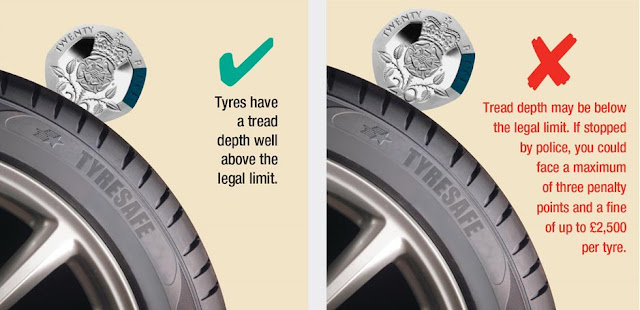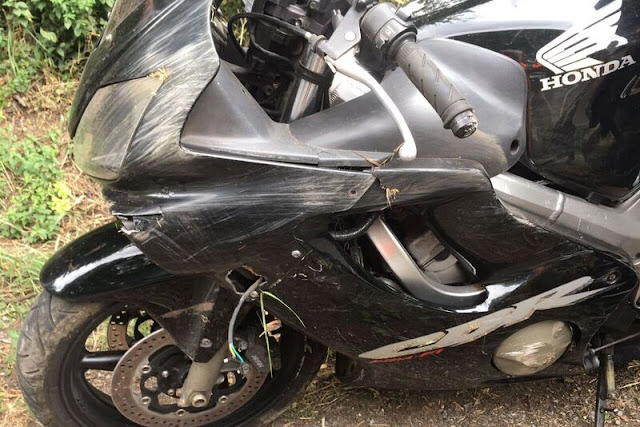Are your tyres ready for winter?
As October draws to a close, it’s time to start thinking about the winter months; warm coats, hearty stews, Christmas shopping, and – of course – checking your tyres...
October is annual Tyre Safety month, and we’ve gathered all
the info you need to know from Tyresafe.org to ensure you know what to look for
ahead of the next few months of potentially adverse weather.
Q: Why should I check
my tyres?
A: On average, 1,075 road casualties every year are from defective tyre related incidents.
A: On average, 1,075 road casualties every year are from defective tyre related incidents.
Tyres should be inspected at least once a month and before
any long journey. Checks should include checking the air pressure, overall
condition and tread depth. And don’t forget to check the spare or the
compressor and sealant if no spare was fitted!
Properly cared for tyres also help to reduce car running costs
and prolong tyre life.
Q: What should I do
when checking my tyres?
A: Tread depths should be checked to ensure they meet the legal minimum regulations. Pressures should be checked in line with the vehicle manufacturers’ recommended settings. Take care to increase the pressure if the vehicle is heavily loaded as shown in the car makers recommendations. The tyres should also be given a thorough visual inspection to look for any cuts, lumps or bulges. Also look for any objects embedded in the tread which should be removed.
A: Tread depths should be checked to ensure they meet the legal minimum regulations. Pressures should be checked in line with the vehicle manufacturers’ recommended settings. Take care to increase the pressure if the vehicle is heavily loaded as shown in the car makers recommendations. The tyres should also be given a thorough visual inspection to look for any cuts, lumps or bulges. Also look for any objects embedded in the tread which should be removed.
Q: Why is tread depth
important?
A: Adequate tread depth is essential for good grip on wet
roads as the tread pattern helps to remove water from between the tyre and the
road surface. Drivers with insufficient tread depth face longer stopping
distances, reduced grip and an increased risk of aquaplaning.
Q: Why is correct
tyre pressure important?
A: To stay safe on the road your car needs to have the
correct tyre pressure. If the tyres are under or over inflated then handling
and grip will worsen, potentially causing irregular or unpredictable car
behaviour.
Tyres with insufficient air are also more likely to suffer
from a sudden rapid deflation and will suffer premature wear on the outside
edges of the tyre. The wheel rim and tyre will be more susceptible to impact
damage.
Over-inflation results in less comfortable ride, a reduced
area of contact with the road giving less grip in the day and accelerated wear
on the tread centre .
Q: How do I check my
tyres?
A: To test your tyre pressure, you need an accurate pressure gauge. Take off the dust cap on the valve, fix on the pressure gauge and take a note of the result. If your tyre needs extra air, you should inflate it using an air pump at home, or use the facilities provided in many petrol stations. If the tyre is overinflated according to the pressure chart, you can allow air to escape whilst the dust cap is off.
When your tyres are at the right pressure, take off the air pipe, make sure there's no dirt in the valve, and re connect the dust cap. (From www.national.co.uk)
A: To test your tyre pressure, you need an accurate pressure gauge. Take off the dust cap on the valve, fix on the pressure gauge and take a note of the result. If your tyre needs extra air, you should inflate it using an air pump at home, or use the facilities provided in many petrol stations. If the tyre is overinflated according to the pressure chart, you can allow air to escape whilst the dust cap is off.
When your tyres are at the right pressure, take off the air pipe, make sure there's no dirt in the valve, and re connect the dust cap. (From www.national.co.uk)
The 20p test
To check the tyre
tread: A quick and easy way to see if your tyre tread exceed the minimum
legal tread depth is to take the 20p test. Simply place a 20p coin into the
main tread grooves of your tyre. If the outer band of the coin is obscured when
it is inserted, then your tread is above the legal limit.
If the outer band of the coin is visible, then your tyres
may be illegal and unsafe and should be checked immediately by a qualified tyre
professional. When taking the test, remember to check at least three locations
around each tyre. As the test is so quick and easy, stay safe by checking your
tyres at least once a month.
There's plenty more on tyre safety available on Tyresafe.org, including information on winter tyres, and a handy tool to find out the optimum air pressure for your make and model of car.
There's plenty more on tyre safety available on Tyresafe.org, including information on winter tyres, and a handy tool to find out the optimum air pressure for your make and model of car.





Comments
Post a Comment